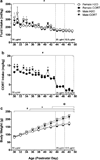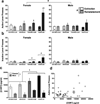Sex differences in reinstatement of alcohol seeking in response to cues and yohimbine in rats with and without a history of adolescent corticosterone exposure
- PMID: 27048157
- PMCID: PMC5604312
- DOI: 10.1007/s00213-016-4278-x
Sex differences in reinstatement of alcohol seeking in response to cues and yohimbine in rats with and without a history of adolescent corticosterone exposure
Abstract
Rationale: Women represent a vulnerable and growing population with respect to alcohol abuse. Elevated glucocorticoid exposure in adolescence increases addiction risk and stress sensitivity in adulthood. However, little is known about sex differences in ethanol craving-like behavior.
Objective: This study characterized sex differences in ethanol-motivated behavior following ethanol-paired cues and/or acute stimulation of the HPA axis in male and female rats with or without exposure to chronically elevated glucocorticoids in adolescence.
Methods: Adolescent corticosterone-treated (Experiment 1) or naïve (Experiment 2) male and female rats were trained as adults to self-administer ethanol paired with a cue, and tested for the effects of this cue, alone or in combination with yohimbine, on the reinstatement of ethanol seeking.
Results: Females showed elevated ethanol self-administration and seeking compared to males. In Experiment 1, corticosterone exposure in adolescence augmented cue-induced reinstatement of ethanol seeking in females only, and females were more sensitive to yohimbine in promoting reinstatement. Experiment 2 replicated these findings and showed that exposure to both yohimbine and alcohol-related cues enhanced the reinstatement of alcohol seeking, producing additive effects in females. Corticosterone levels were higher in females and in yohimbine-treated rats, and corticosterone and estradiol correlated with responding during reinstatement.
Conclusions: Chronic manipulations in adolescence and acute manipulations in adulthood of the HPA axis increase cue-induced reinstatement of ethanol seeking to a greater degree in females than in males. Elucidating the mechanisms that underlie these effects may lead to the development of sex-specific interventions aimed at mitigating alcohol relapse risk in females.
Keywords: Adolescence; Craving; Ethanol; Female; Relapse; Self-administration; Stress.
Conflict of interest statement
The authors report no conflicts of interest.
Figures








References
-
- Anker JJ, Carroll ME. Females are more vulnerable to drug abuse than males: evidence from preclinical studies and the role of ovarian hormones. Curr Top Behav Neurosci. 2011;8:73–96. - PubMed
-
- Barha CK, Brummelte S, Lieblich SE, Galea LA. Chronic restraint stress in adolescence differentially influences hypothalamic-pituitary-adrenal axis function and adult hippocampal neurogenesis in male and female rats. Hippocampus. 2011;21:1216–1227. - PubMed
Publication types
MeSH terms
Substances
Grants and funding
LinkOut - more resources
Full Text Sources
Other Literature Sources

